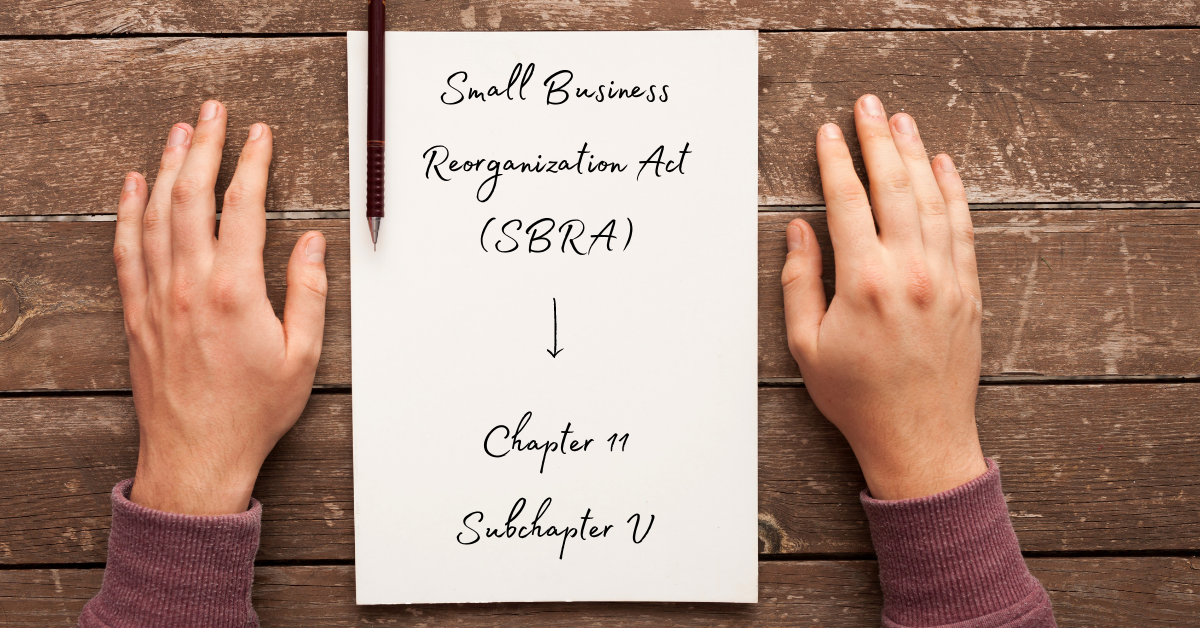Dealing with debt can be an overwhelming and stressful experience, especially for small business owners. If you’re a small business owner in Florida struggling with debt, you may feel like there’s no way out. However, there is a solution that could help you regain control of your business’s finances and secure a brighter future: Chapter 11 Subchapter 5. This lesser-known and relatively new bankruptcy option offers a more streamlined and cost-effective approach to debt reorganization, specifically designed for small businesses.
What is Chapter 11 Subchapter 5?

Chapter 11 Subchapter 5, also known as the Small Business Reorganization Act (SBRA), became effective in 2020 to provide a more accessible and efficient bankruptcy option for small business owners. It simplifies the traditional Chapter 11 bankruptcy process, making it easier and more affordable for small businesses to reorganize their debts and continue their business activities.
How Does Chapter 11 Subchapter 5 Work?
Under Chapter 11 Subchapter 5, small business owners can reorganize their secured and unsecured debt, negotiate with creditors, and create a feasible plan to repay their debts over a period of time while continuing their business operations. Some of the key features of Chapter 11 Subchapter 5 include:
– Streamlined Process: Subchapter 5 eliminates many of the cumbersome requirements of traditional Chapter 11, such as the need for a disclosure statement and the appointment of a creditors’ committee. This results in a faster and less expensive bankruptcy process.
– Debtor in Possession: In a Subchapter 5 bankruptcy case, the small business owner (the debtor) remains in control of their business operations as a debtor in possession, unless the bankruptcy court orders otherwise.
– Trustee’s Role: A Subchapter 5 trustee is appointed to help facilitate the bankruptcy process and works with the debtor to develop a reorganization plan that is feasible and fair to all parties. However, unlike a traditional Chapter 11 case, the trustee does not take over the debtor’s business operations.
– Reorganization Plan: The debtor has 90 days to propose a reorganization plan, which must be approved by the bankruptcy court. The plan should outline how the debtor will repay their debts using their projected disposable income, over a three to five-year period.
– Cramdown Provision: Subchapter 5 allows for the cramdown of certain secured debts, meaning that the debtor can reduce the debt to the current market value of the collateral securing the debt, even without the consent of the secured creditor.
– Discharge of Debts: Upon successful completion of the reorganization plan, the debtor will receive a discharge of their remaining unsecured debts, allowing them to move forward with a clean financial slate.
Who is Eligible for Chapter 11 Subchapter 5?

To qualify for Chapter 11 Subchapter 5, a small business debtor must meet the following criteria:
1. Be engaged in commercial or business activities, excluding real estate businesses.
2. Have aggregate noncontingent liquidated secured and unsecured debts of no more than $7.5 million, excluding debts owed to affiliates or insiders.
3. At least 50% of the debtor’s debts must have arisen from their business activities.
If your small business meets these eligibility requirements, Chapter 11 Subchapter 5 could be a lifeline to help you regain control of your business’s financial future. However, navigating the bankruptcy process can be complex, and it’s essential to consult with an experienced bankruptcy attorney to ensure that you make the most informed decisions possible for your business.
Benefits of Chapter 11 Subchapter 5 for Small Business Owners
Chapter 11 Subchapter 5 offers several advantages for small business owners facing financial difficulties. Some of the key benefits include:
– Cost-Effective: The streamlined process of Subchapter 5 reduces the overall cost of bankruptcy, making it a more affordable option for small businesses. The elimination of certain requirements, such as the disclosure statement and creditors’ committee, helps to minimize legal and administrative expenses.
– Time-Saving: Subchapter 5 bankruptcy can save time for small businesses because it simplifies certain aspects of the Chapter 11 process, allowing business owners to focus on rebuilding their businesses sooner. For example, small businesses are not required to file a detailed disclosure statement, which can be time-consuming.
– Flexibility: Subchapter 5 provides small business debtors with the opportunity to renegotiate contracts and leases, reduce expenses, and restructure their debts in a manner that best suits their unique circumstances.
– Continued Business Operations: Chapter 11 Subchapter 5 allows small business owners to remain in control of their businesses as debtors in possession, ensuring that they can continue their business activities during the bankruptcy process.
– Improved Credit: While bankruptcy can initially have a negative impact on credit scores, successfully completing a Chapter 11 Subchapter 5 bankruptcy can help small business owners rebuild their credit over time by demonstrating responsible financial management.
Understanding the Role of the Bankruptcy Court and Trustee
The bankruptcy court plays a critical role in the Chapter 11 Subchapter 5 process, overseeing the case and ensuring that the debtor’s reorganization plan is feasible and in the best interest of the creditors. The court is responsible for approving the debtor’s actions during the bankruptcy process, such as selling assets or obtaining new financing, and ultimately deciding whether to confirm the reorganization plan.
The Subchapter 5 trustee is appointed by the United States Trustee to facilitate the bankruptcy process and protect the interests of the creditors. The trustee’s responsibilities include:
- Reviewing the debtor’s financial information and reorganization plan
- Ensuring that the debtor is dedicating their projected disposable income to the repayment of their unsecured debts
- Monitoring the debtor’s business activities and compliance with the bankruptcy code
- Helping to resolve disputes between the debtor and their creditors
- Providing recommendations to the bankruptcy court regarding the confirmation of the reorganization plan
It is important for small business owners to understand the roles of the bankruptcy court and trustee in the Chapter 11 Subchapter 5 process and to cooperate with them to ensure a successful outcome.
Preparing for a Chapter 11 Subchapter 5 Bankruptcy Filing

If you believe that Chapter 11 Subchapter 5 may be the right solution for your small business, it is essential to prepare for the bankruptcy filing by taking the steps below.
1. Consult with an experienced bankruptcy attorney who can help you navigate the complex bankruptcy process and ensure that you make the most informed decisions possible for your business.
2. Gather all relevant financial information, including your business’s assets, liabilities, income, and expenses, as well as any contracts, leases, and other legal documents. This information will be crucial in developing your reorganization plan and providing the required financial disclosures to the bankruptcy court and creditors.
3. Develop a feasible reorganization plan that outlines how you will repay your debts over a three to five-year period. This plan should take into account your business’s current financial situation and future projections, and it must be approved by the bankruptcy court.
4. Communicate with your creditors, employees, and other stakeholders about your decision to file for Chapter 11 Subchapter 5 bankruptcy. Transparency and open communication can help to maintain relationships and build trust during the bankruptcy process.
By taking these steps and working closely with an experienced bankruptcy attorney, small business owners can maximize the benefits of Chapter 11 Subchapter 5 and secure a brighter financial future for their businesses.
Navigating the Small Business Reorganization Act
The Small Business Reorganization Act (SBRA) was enacted to provide a more accessible and efficient bankruptcy process for small businesses. This legislation introduced Chapter 11 Subchapter 5, which streamlines the traditional Chapter 11 process for eligible small business debtors. Understanding the key provisions of the SBRA can help small business owners navigate the bankruptcy process more effectively.
Simplified Plan Confirmation Process
One of the most significant changes under the SBRA is the simplified process for confirming a reorganization plan. In a traditional Chapter 11 case, the debtor must obtain creditor approval for their reorganization plan. However, under Subchapter 5, only the debtor can propose a plan, and there is no requirement for creditor approval. This streamlined process can save time and resources for small business debtors.
Greater Flexibility in Repaying Secured and Unsecured Debts
Chapter 11 Subchapter 5 provides small business debtors with greater flexibility in repaying their secured and unsecured debts. For example, in some circumstances, the SBRA allows small businesses to modify the terms of certain secured debts (and to keep the business operating to be more able to pay the unsecured debts).
Addressing Unique Challenges for Small Businesses in Chapter 11 Subchapter 5

Small businesses face unique challenges when navigating the bankruptcy process, and Chapter 11 Subchapter 5 is designed to address these issues. Some of the ways that Subchapter 5 helps small businesses overcome these challenges include:
Streamlined Reporting Requirements
In a traditional Chapter 11 case, businesses must comply with extensive reporting requirements, which can be burdensome for small business owners. Under Subchapter 5, the reporting requirements are streamlined, reducing the administrative burden on small businesses and allowing them to focus on their continued business operations.
Ability to Retain Ownership and Control
One of the key benefits of Chapter 11 Subchapter 5 for small business owners is the ability to retain ownership and control of their business during the bankruptcy process. This allows small business owners to preserve jobs, and maintain relationships with customers and suppliers.
Access to Post-Petition Financing
Small businesses often require additional financing during the bankruptcy process to fund their reorganization plan and continue their business operations. Chapter 11 Subchapter 5 allows small business debtors to obtain post-petition financing with the approval of the bankruptcy court, providing the necessary resources to implement their reorganization plan and emerge from bankruptcy stronger.
The Importance of Professional Guidance in Chapter 11 Subchapter 5

Navigating the complex bankruptcy process can be challenging for small business owners, and the assistance of an experienced bankruptcy attorney is essential. A knowledgeable attorney can help you understand the intricacies of Chapter 11 Subchapter 5, develop a feasible reorganization plan, and guide you through the bankruptcy process to ensure a successful outcome.
By working closely with a skilled bankruptcy attorney, small business owners can maximize the benefits of Chapter 11 Subchapter 5 and secure a brighter financial future for their businesses.
How Chapter 11 Subchapter 5 Can Improve Credit Scores
While it is true that filing for bankruptcy can have a negative impact on credit scores, the long-term benefits of a successful Chapter 11 Subchapter 5 reorganization can outweigh the initial credit score dip. By restructuring debts and implementing a feasible reorganization plan, small businesses can gradually improve their financial standing and, in turn, their credit scores.
To help rebuild credit after a bankruptcy filing, small business owners should focus on maintaining timely payments, reducing debt balances, and monitoring their credit reports for accuracy. By demonstrating responsible financial management and adhering to the reorganization plan, small businesses can recover from bankruptcy and improve their credit scores over time.
Overcoming the Stigma of Bankruptcy with Chapter 11 Subchapter 5
Bankruptcy is often perceived as a sign of failure, but it is essential to recognize that it is a financial tool designed to help businesses and individuals overcome financial challenges. Chapter 11 Subchapter 5, in particular, offers a streamlined and efficient process for small businesses to restructure their debts and continue their commercial or business activities.
By embracing the opportunity to reorganize under Chapter 11 Subchapter 5, small business owners can alleviate the burden of overwhelming debt and focus on rebuilding their businesses. The stigma surrounding bankruptcy should not deter business owners from seeking the relief they need. With the right guidance and support from experienced bankruptcy professionals, small businesses can emerge from Chapter 11 Subchapter 5 stronger and better positioned for future success.
The Role of Creditors in the Chapter 11 Subchapter 5 Process
Creditors play a crucial role in the Chapter 11 Subchapter 5 bankruptcy process. They are divided into classes based on the type of debt they hold, secured or unsecured. Secured creditors have a security interest in the debtor’s property, while unsecured creditors do not require any collateral to secure their claims.
During the reorganization process, the debtor must submit a plan of reorganization that details how they will repay their creditors. Creditors have the opportunity to review the plan and, in some cases, may vote on whether to accept or reject it. The bankruptcy court will consider the views of creditors when determining whether to confirm the plan.
Unsecured creditors are particularly important in the Chapter 11 Subchapter 5 process, as their claims are often subject to adjustment under the debtor’s reorganization plan. The debtor may propose to pay a percentage of their unsecured debts or extend the repayment period, subject to the requirements of the bankruptcy code and the court’s approval.
It is essential for small business owners to maintain open communication with their creditors throughout the Chapter 11 Subchapter 5 process. By working together and demonstrating a commitment to repaying debts to the best of their ability, debtors can improve their relationships with creditors and increase the likelihood of a successful reorganization.
Chapter 11 Subchapter 5 Frequently Asked Questions
Navigating the Chapter 11 Subchapter 5 bankruptcy process can be complex and challenging. To help you better understand this financial tool and how it can benefit your small business, we have compiled a list of frequently asked questions and their answers.
How long does the Chapter 11 Subchapter 5 process take?
The duration of the Chapter 11 Subchapter 5 process can vary depending on the complexity of the case and the debtor’s ability to propose and implement a feasible reorganization plan. Generally, the debtor has 90 days from the date of filing to submit their plan, but this deadline may be extended by the court in certain circumstances.
What is the difference between traditional Chapter 11 and Chapter 11 Subchapter 5?
Subchapter 5 is a streamlined version of traditional Chapter 11 bankruptcy designed specifically for small businesses. It offers a faster, less expensive, and more efficient process for debt reorganization. Some key differences include the appointment of a Subchapter 5 trustee to assist in the reorganization process, the absence of a creditors’ committee, and simplified reporting and disclosure requirements.
Can I keep my business open during the Chapter 11 Subchapter 5 process?
Yes, in most cases, small business owners can continue to operate their businesses during the Chapter 11 Subchapter 5 process. The debtor remains in control of their business as a “debtor in possession” and can make decisions related to the day-to-day operations and the implementation of the reorganization plan.
How does Chapter 11 Subchapter 5 impact my personal credit?
Filing for Chapter 11 Subchapter 5 bankruptcy may initially have a negative impact on your personal credit. However, by successfully completing the reorganization process and adhering to the repayment plan, you can gradually rebuild your credit over time.
How much does it cost to file for Chapter 11 Subchapter 5?
The filing fees for Chapter 11 Subchapter 5 are lower than those for traditional Chapter 11 bankruptcy. As of September 2022, the filing fee for a Subchapter 5 case is $1,738. Additionally, legal and professional fees may vary depending on the complexity of the case and the level of support required.
Can I convert my Chapter 11 Subchapter 5 case to a different type of bankruptcy?
Yes, under certain circumstances, a Chapter 11 Subchapter 5 case can be converted to a different type of bankruptcy, such as Chapter 7 liquidation. However, this decision should be made in consultation with an experienced bankruptcy attorney who can advise on the best course of action for your specific situation.
Contact Us to Learn More About Chapter 11 Subchapter 5

If you are a small business owner in South Florida struggling with debt and considering your options, LSS Law is here to help. Our experienced bankruptcy attorneys can guide you through the Chapter 11 Subchapter 5 process and develop a tailored strategy to reorganize your debt and secure a brighter financial future for your business.
To schedule a free consultation for personal bankruptcies (Chapter 7 and Chapter 13), or to schedule a business bankruptcy consultation, call us at 954-466-0541 or email us at info@lss.law.






